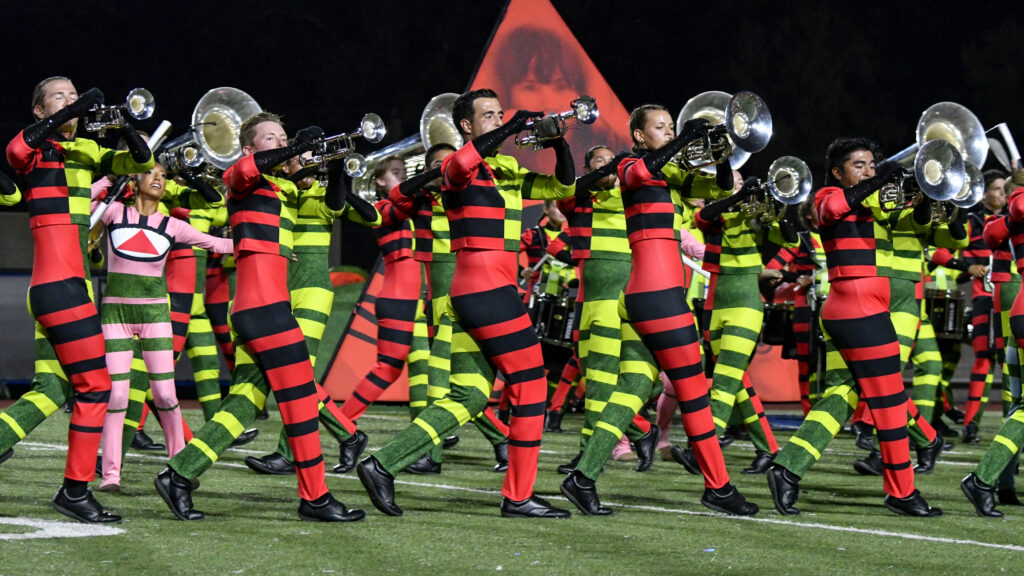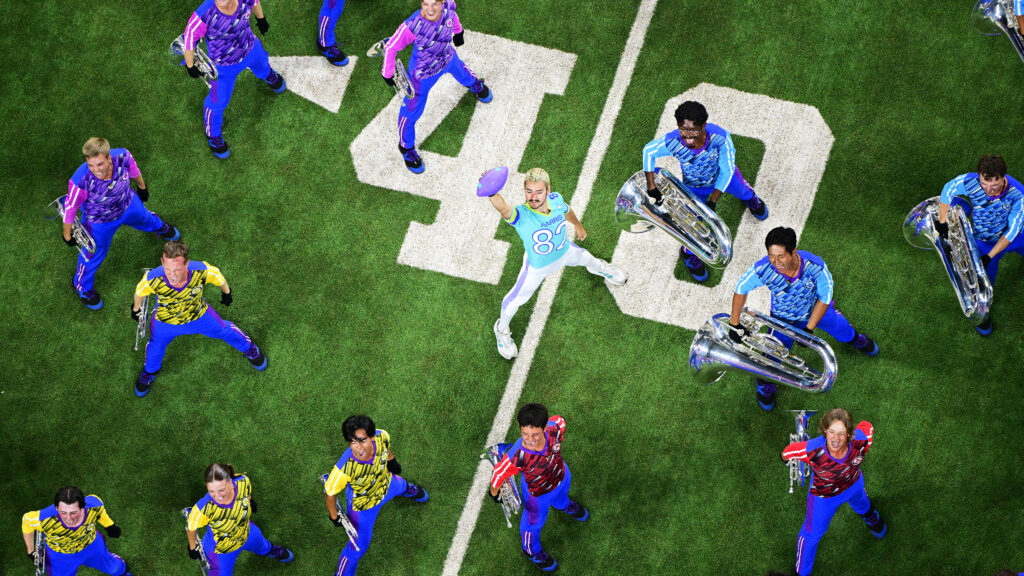The 2007 Drum Corps International Tour marked the first time DCI brought its World Championship west of the Rockies to iconic Rose Bowl Stadium in Pasadena, California.
The Blue Devils celebrated their organization’s 50th anniversary by picking up their 12th DCI title after squeaking past the Cadets by just 0.05 points in the Semifinals competition. Keeping things interesting on the way to the title, the Devils had lost to the fifth-place Santa Clara Vanguard twice and seventh-place Bluecoats once. Even more interesting, Bluecoats had beaten each of the top six World Class corps at least once during the summer, ultimately earning the highest seventh-place score in DCI history.
Santa Clara Vanguard finished 2007 in fifth place with “!,” pronounced “Eureka!” The word has long been used to express a sudden discovery, literally meaning, “I have found it,” and is the motto of the State of California. In addition to the times exclamation marks appeared in the drill formations, the color guard costumes had a wide interrupted white stripe running down the left leg that made sure exclamation marks were constantly in view.
The show started with the mysteriously atmospheric “Introduction” from Maurice Ravel’s “Daphnis and Chloé,” written in 1912. Ravel, one of the most famous French impressionistic composers, contributed four selections to the show. Ravel is perhaps best known to audiences as the orchestral arranger of the most well-known rendition of Mussorgsky’s piano suite, “Pictures at an Exhibition,” and as the composer of the famed “Bolero.”
“Daphnis and Chloé” was based on a love story by ancient Greek novelist Longus. The ballet is in one act and three scenes, commissioned in 1909 by Sergei Diaghilev for the Ballet Russes, the same impresario and ballet troupe that soon after commissioned Igor Stravinsky to write “The Firebird.” At an hour in length, the ballet became Ravel’s longest work. Santa Clara Vanguard’s selections were based on the orchestral suites Ravel extracted from the ballet.
“Introduction” was essentially very quiet, like listening to faraway music through a fog. But when the horns came together in a block form for a big hit, the contrast between soft and loud was jarring. The loud segment led the corps into the second selection (and the end of “Part One” of the show), the savage “War Dance,” also from “Daphnis and Chloé.” When two forms that appeared to be mirror images came together to form an exclamation mark, the audience, well-trained, shouted out, “Eureka!”

“Part Two” of the show started with the second movement of Ravel’s “String Quartet in F Major,” composed in 1903. Some musicologists believe the movement was influenced by the Javanese gamelan, which Ravel heard in Paris in 1889. Such sounds could easily be heard in the musical mode of Vanguard’s introductory mallet percussion work. Most of this segment was a percussion feature.
The corps’ “Part Two” segment concluded with Béla Bartók’s “Romanian Dance for Orchestra” of 1911, based on the Hungarian composer’s first movement from his earlier “Romanian Dances” for piano. Although influenced by his extensive folk music research, the melody was not based on any pre-existing folk song, as was so often the case in his music. The piece is known for a strong pounding percussive primitivism and chords based on unorthodox tonalities. Its musical characteristics allowed it to sound as if it was a continuation of the Ravel string quartet. The end of the piece as performed by Santa Clara Vanguard quietly segued into the next movement of the show.

“Part Three” started with the grandeur of Ottorino Respighi’s “St. Gregory the Great” from his “Church Windows” of 1925. Respighi is best known for “Roman Trilogy,” which includes the famed “Pines of Rome.” Each of the four movements of “Church Windows” refers to different Italian stained glass windows, though the descriptive titles of each of the four movements were added after the music was composed. “St. Gregory the Great” is the final movement, based on the “Gloria” from the “Missa de Angelis.”
References to church bells were heard in the introductory Gregorian chant of “St. Gregory the Great.” The piece reached a dramatic climax with the horns stretching in two straight lines from the lower left corner of the field to the circles of drums surrounding the color guard members, which created another impossible-to-miss exclamation mark. An even greater climax was attained at the end of this segment when the horns replicated the great organ solo ending the original, stepping on their knees into a salute to the corps’ trademark “Bottle Dance.”
The finale of the show was the lively “Bacchanale” from “Daphnis and Chloé,” the part of the ballet suite most performed in concert halls. The horns moved into a tight square block, giving the audience a second chance to participate in contributing to the show, when all yelled, “Vanguard!” A soft musical tag by the front ensemble had the horns move into the top of a final exclamation mark, the battery percussion forming the bottom dot, as the cymbals formed their “V-for-Vanguard” in the center of the drums.
2007 World Championship Awards Ceremony

Michael Boo was a member of the Cavaliers from 1975-1977. He wrote about the drum corps activity for more than 35 years while serving as a staff writer for various Drum Corps International projects. During his lifetime Boo wrote for numerous other publications including an honors-winning book on the history of figure skating. He also was an accomplished composer. Boo passed away in 2020 and was inducted into the DCI Hall of Fame posthumously in 2021.





